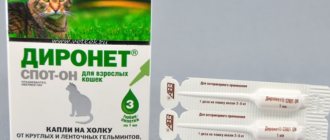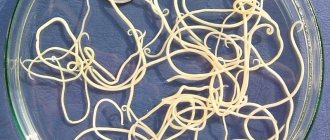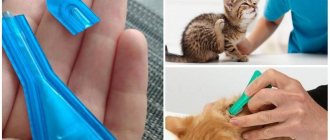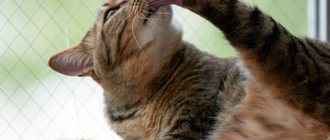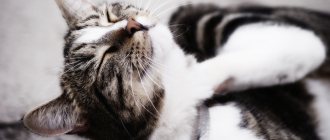Features of the life of fleas
Cat fleas are wingless insects that feed on blood. They are perfectly adapted to move quickly between hairs. The body of the parasites is flattened on the sides. Special combs of thorns also allow insects to easily penetrate the fur. The entire body of fleas is covered with them. The hind legs of parasites are well developed, which gives them the ability to jump high.
Without food, a flea can live up to one and a half years. But if he sees a cat, he will immediately start eating. Since the parasite's stomach stretches well, the amount of blood consumed can be significant.
Insects reproduce very quickly - an adult can lay up to 400 eggs. Since the eggs are not attached to the fur, they can fall anywhere - on the carpet, sofa or floor.
Cat fleas are perfectly adapted to move quickly between animal hairs.
Flea larvae mature within 12 days. But insects can remain in the “shelter” for a month, until a cat passes nearby. If the parasite senses an animal nearby, it will definitely come out and try to get on the cat. The female will then strive to lay eggs and the male will begin fertilization. After a week, your pet may already have up to 200 fleas.
Infected animals experience severe itching. Among other things, scratching their skin can cause dermatitis and then hair loss. In kittens, these symptoms worsen - they quickly lose weight, and if there are a lot of parasites, the kitten may die.
Contraindications for use
The drops pose the greatest danger to nursing cats with small kittens aged from birth to four months. A cat may perceive the drops on her children as an attempt to wean them from their mother, and will begin to lick them profusely, which can lead to severe poisoning.
Also, small kittens, while playing, can accidentally bite each other and also “eat” substances harmful to their fragile organisms. A healthy adult cat in such a situation may simply feel unwell and not touch food for several days.
There are cases when insecticides can cause allergies in a cat, hair loss at the site of application of the drops, and even dermatitis. However, these cases are extremely rare, and before use, you should apply a small amount of the product to the paw or side of the animal's body to check the reaction.
But for fleas, the drops pose a mortal danger. Most parasites die instantly as soon as they come into contact with the place where the drops are smeared . The rest immediately run away from the cat’s body, wanting to hide from the unpleasant smell as soon as possible. If you have rid your cat of fleas, and you have a budgie, then a flea can easily settle on the bird. Read about treating parrots for these parasites here.
What blogs look like in a cat's fur
Popular types of drops
"Advantage"
Apply to the withers. The active ingredient is imidacloprid. Protection lasts for a month. It is important that the cat does not lick itself for a couple of hours.
"Advantage" is produced by a reputable German manufacturer Bayer Health Care
"Leopard"
A domestic drug that has won many positive reviews. The composition contains insecticides that are safe for animals. The cost is very affordable - up to 100 rubles.
"Beaphar"
Dutch flea product. Suitable for kittens, cats, weakened animals. A distinctive feature is the replacement of insecticides with margosa extract, which is absolutely safe for cats when licked.
"Hartz"
The most popular drops made in America. The active ingredient is methoprene; the drug is not suitable for use by kittens under 12 weeks of age.
"Beaphar" flea remedy made in Holland
"Frontline"
Suitable for protection against fleas and worms. Supplied in pipettes. Approved for use in kittens over 2 months old.
Advantages and disadvantages of using drops
Flea drops have many undeniable advantages over other forms of anti-flea medications.
Advantages:
- act quickly (within 20 minutes the cat will feel better, and a few days later the parasites will die);
- effective (reliably protect the cat from fleas for at least 1–2 months);
- relatively safe;
- convenient to use.
Unfortunately, this remedy is not suitable for everyone. In some cases, it needs to be replaced with other means or processing must be postponed for some time.
Flaws:
- may cause allergies;
- not suitable for small kittens, pregnant or lactating cats;
- dangerous for sick, exhausted, weakened animals.
Leopard
Application rules
It is better to apply drops to the withers. In this case, the cat will not lick them off.
The most reliable protection against fleas and worms is provided when the correct dosage is chosen - according to the weight of the pet. It is important to weigh the animal before applying the solution.
Wash your hands thoroughly when using flea treatment. If your throat is sore, drink water.
You can learn about measures to prevent fleas in cats here.
How to avoid giving the younger generation of fleas a chance?
The best option for preventing subsequent infestations is to wear an anti-flea collar for animals (at least outside) and to remove fleas in the house. The last procedure is even more complicated than ridding the animal itself of fleas, but it also guarantees the protection of all inhabitants of the house - including people.
It will also be useful to regularly place wormwood branches under the cat’s bedding (tansy can also be used for the same purposes). If desired, herbs can be replaced with fumigators.
Fleas are a fairly common problem; every owner of a domestic cat encounters it at least once. These insects can cause a lot of trouble for the animal; they should be removed as soon as possible, using one of the proven and effective methods.
Operating principle
There is no need to rub drops containing celandine into the animal’s fur. The product acts externally and does not penetrate into the blood . The parasites die within 24 hours; for optimal results, you should not bathe your pet for 48 hours. It is recommended that the animal not have contact with small children for 2 days after treatment.
If you wait the specified time, drops containing celandine or another substance will reliably protect the cat from parasites for a period of one to two months. At this time, it is necessary to thoroughly clean the litter and baseboards. If your pet is walking outside, re-treatment will be required.
There is no need to rub drops containing celandine into the animal’s fur.
What affects the effectiveness of drops?
Success in flea control depends on the appropriate dose of medication and following safety precautions. Cleanliness in the house where a kitten lives plays a vital role in maintaining its health. It is necessary to treat not only the pet itself with flea remedies, but also the entire room. When the parasites disappear from the home, there will be no sources of infection left, which means the cat will be reliably protected from parasites.
The room can be sprayed with anti-flea spray. But a more noticeable effect will come from washing the floors with flea repellent. A small amount of the drug should be diluted in a bucket of water and the floors should be washed with this liquid.
Attention! After treating the floors in the apartment, you must carefully ensure that cats do not pick up anything from the floor or lick it.
Danger of fleas
Precautionary measures
Most drops are safe when applied to the withers. However, precautions should be taken:
- For the first few days, monitor the condition of your pet’s neck; allergies may appear.
- Make sure your cat doesn't start licking the product.
- Make sure that drops do not get into your mouth or eyes.
Regardless of what medications you use, monitor your pet's reaction. If there is an increase in body temperature, nausea, shortness of breath, vomiting, wash off the product and contact a veterinarian.
It is contraindicated to use drops for pregnant and lactating animals, for kittens whose age has not reached 10 weeks
Slight salivation when using drops where celandine is located is normal. After the cat's fleas are removed, treat the entire house, especially baseboards and high-pile carpets. Otherwise, soon the parasites will attack the animal again, and the anti-flea drug will stop working.
Components of drip preparations
Flea drops for cats contain various types of toxic substances, and some types of drops do not contain toxic substances, but repellents that repel bloodsuckers. Not so long ago, anti-flea drugs were created on the basis of highly toxic compounds, for example, COCs.
However, the active substances of the vast majority of modern products are low or moderately dangerous. In the absence of contraindications and individual intolerance in the animal, the dosage is observed and used correctly, they do not cause negative consequences.
Varieties
In the production of insecticides for cats, the following groups of substances are used:
- avermectins;
- isoxazolines;
- chitin synthesis inhibitors;
- fipronil or phenylpyrazoles;
- pyrethroids;
- neonicotinoids;
- carbamates.
The composition of medications for cats most often includes:
- fipronil;
- imidacloprine;
- diazinon;
- moxidectin;
- Methoprene
It is the active substance that determines the mechanism of action of the drops, their toxicity, basic properties, and dosage.
Flea remedies (video)
The drug against worms and fleas gives effect after just a day. Fleas fall from the animal onto the bedding. The effect lasts for up to a month. The price per tube varies - it all depends on the manufacturer. Drops against parasites can be produced for use not only by cats, but also by dogs. For cats, the capsules are enough for 4 applications.
Drops will help protect your pet from fleas. There are many varieties of them, differing in composition and toxicity. Before treating an animal, you should consult a doctor.
Signs of an animal being infected with fleas
Domestic fluffies that do not walk in the yard at all are not immune from attacks by blood-sucking insects. The penetration of fleas or ticks into an apartment is possible, and often this cannot be avoided. The entrance, balcony, shoes and clothes of the owner are all sources through which a pet can become infected with fleas.
© shutterstock
Main symptoms of an infected animal:
- Frequent, exhausting scratching;
- weakness and fatigue;
- lack of sleep;
- loss of appetite;
- nervous state.
All of the above indicates that the cat is infected with fleas, which mercilessly bite the pet. The presence of bloodsuckers can be detected by combing the fur onto a light towel. Along with the fibers, small moving black dots will be noticeable on the litter - this indicates that the fluffy dog has fleas. If the hypothesis is confirmed, then immediately contact a veterinary pharmacy and purchase a good remedy, and also consult a doctor about how to administer flea drops to a cat, and find out about their use.
What happens to fleas after treatment?
If the flea drops are based on a repellent, then after treatment the insects quickly leave the animal in order to be as far as possible from the unpleasant odor. If the drug is insecticidal, then it affects the nervous system of parasites, blocking receptors and disrupting the transmission of nerve impulses, as a result of which:
- fleas lose their ability to reproduce;
- insects cannot eat, breathe, move and die from paralysis.
Many drugs act not only on mature individuals, but also on larvae. The active substance penetrates into the egg, causing the death of the larva.
At what age are flea drops used?
Before you start using flea drops for cats, you must familiarize yourself with the age restrictions. They differ quite seriously for drugs from different brands and are always indicated in the instructions.
Most often, drops are allowed to be used for pets older than 2.5 - 3 months. If the animal is younger, then the product may do more harm than good. This is especially true for children who are under the care of their mother. While washing the baby, she licks off part of the drug, which gets into the milk, and with it into the kitten’s body, causing intoxication.
Kitten treatment
But fleas can plague kittens from birth. To alleviate the condition of a small pet, comb it out, bathe it in a saline solution or a special shampoo (after making sure that it is age appropriate).

